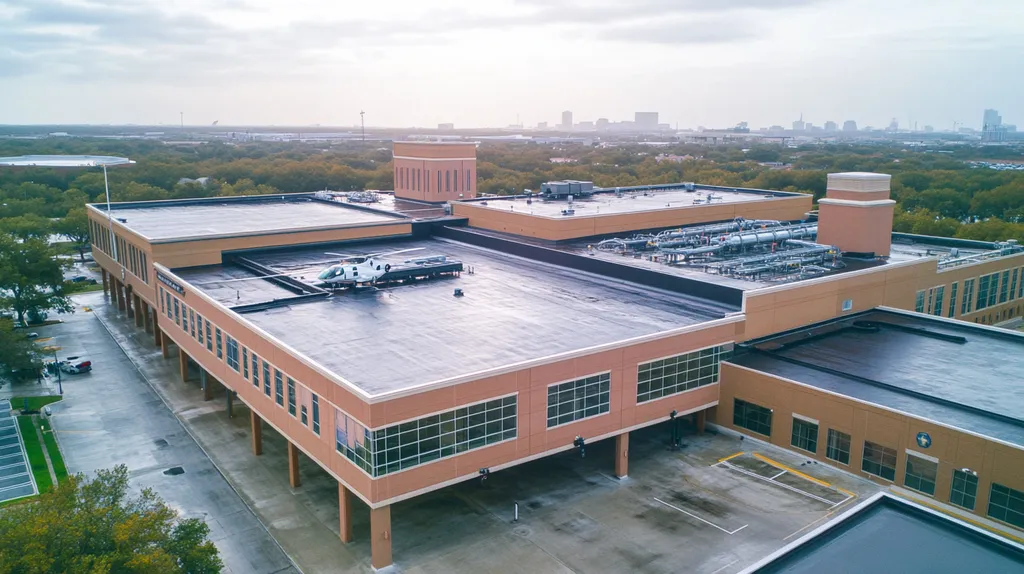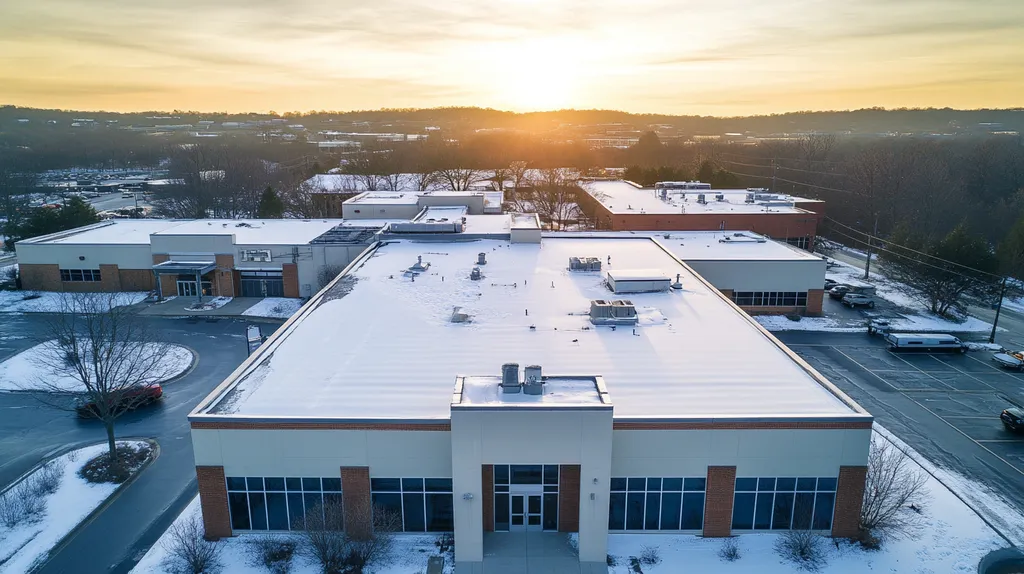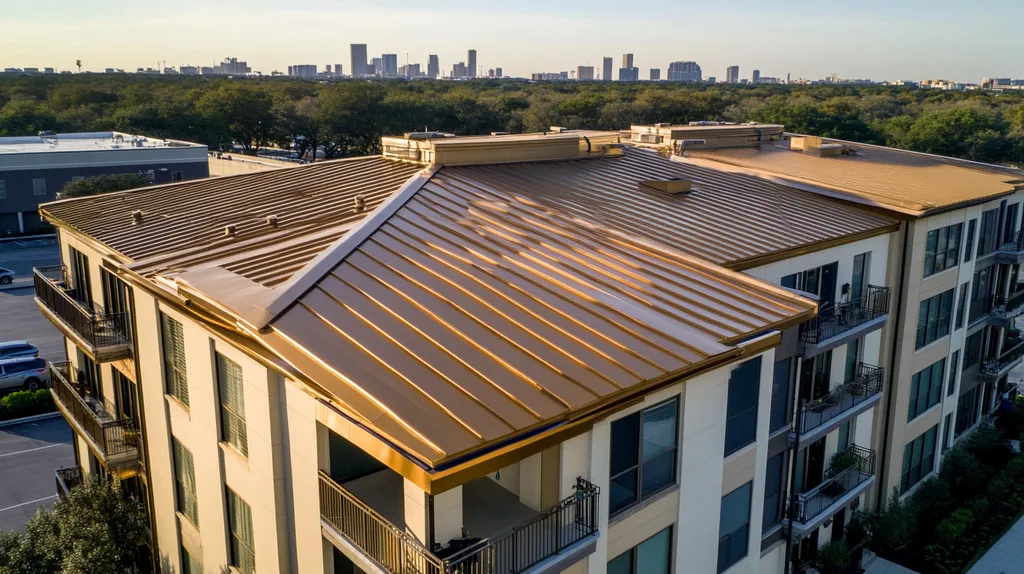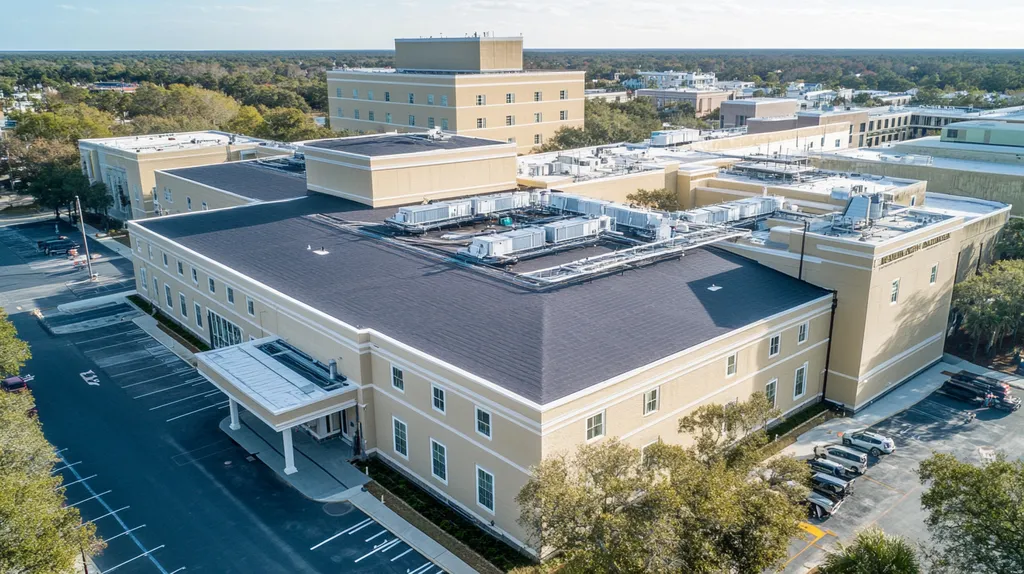When it comes to commercial roofing projects, a shocking 73% of facility managers report significant tenant disruptions due to poor activity coordination. These disruptions cost businesses an average of $5,000 per day in lost productivity and operational delays.
For facility managers, successfully orchestrating tenant activities on commercial roofs requires mastering a complex dance of scheduling, safety protocols, and clear communication. The stakes are high – one misstep can lead to costly damages, injured workers, or business interruptions.
This comprehensive guide breaks down the essential factors facility managers must consider, from performance metrics to financial planning, compliance requirements, and risk management strategies. By following these actionable solutions, managers can ensure smooth operations while protecting both property and tenant interests.
SECTION 1: PERFORMANCE FACTORS
Coordinating roofing activities with tenant operations is essential for ensuring a smooth workflow in commercial facilities. Roofing repairs and maintenance can disrupt tenant productivity and even impact their bottom line. In fact, around 75% of tenants report that maintenance disruptions often lead to significant operational challenges. To navigate these hurdles, facility managers must engage in meticulous planning that encompasses timing, communication, and quality control. This section dives into how roof repairs influence tenant activities, offers strategies to minimize disruptions, and highlights the importance of delivering top-notch roofing work.
Impact of Roof Repairs on Tenant Operations
Roof repairs can significantly influence tenant operations, affecting everything from employee productivity to customer satisfaction. For example, noisy hammering or restricted access might deter clients and disrupt routines. This can lead to financial losses, especially for businesses that thrive on foot traffic, such as retail stores.
The level of disruption often varies based on tenant operations. A tech company might adapt more easily to interruptions than a bustling restaurant that depends on a stable atmosphere. Hence, understanding the specific needs of tenants is key to scheduling repairs that minimize their inconvenience.
Facility managers should maintain open communication with tenants throughout roofing projects. By sharing repair schedules and potential impacts, tenants can plan accordingly, reducing misunderstandings and establishing a collaborative atmosphere with property managers.
Key Action Items
Minimizing Disruptions to Tenant Schedules
To minimize disruptions during roofing work, meticulous planning and effective communication are crucial. Facility managers should develop a clear timeline for repairs and communicate it to tenants well ahead of time. Providing timely updates on any changes can help tenants adjust their operations without a hitch.
One practical strategy is to conduct repairs during off-peak hours. For instance, scheduling particularly noisy work for early mornings or late evenings can significantly lessen the impact on daily business activities. Understanding each tenant’s operational hours enables managers to create a considerate roofing schedule.
Additionally, employing sound barriers or using quieter tools can further reduce noise and disturbances. This commitment to tenant comfort demonstrates a facility manager’s dedication to providing a supportive environment, which not only benefits current tenants but also enhances the property’s overall appeal.
Key Action Items
Ensuring Roofing Work Quality and Efficiency
The caliber of roofing work plays a critical role in tenant satisfaction and overall safety. Subpar repairs can result in leaks or structural complications, which in turn disrupt tenant operations. Therefore, facility managers should focus on hiring competent roofing contractors with proven success in delivering quality results.
In addition to vetting contractors, it is crucial to implement strict oversight throughout the repair process. Regular inspections, both during and after the roof work, can catch issues early, ultimately safeguarding tenant interests.
Employing effective project management techniques will also enhance the overall performance of roofing jobs. Establishing clear objectives and a defined scope can help contractors maintain productivity and focus, leading to timely job completions that reduce tenant disruptions.
Key Action Items
SECTION 2: FINANCIAL CONSIDERATIONS
Grasping the financial landscape of roof management is vitally important for facility managers. Misjudging repair budgets can unleash unexpected expenses that throw a wrench in operations. Alarmingly, 30% of commercial roofs need replacing due to neglect, resulting in costs that can soar into the hundreds of thousands. By addressing these financial factors, such as budgeting for timely maintenance and anticipating tenant disruptions, managers can safeguard their resources and reduce operational risks.
Budgeting for Roof Repairs and Maintenance
Smart budgeting for roof repairs is all about being proactive and prepared. Facility managers should earmark a specific percentage of the property’s value—generally between 1% to 3% annually—for maintenance costs. This foresight creates a financial cushion for essential repairs before they snowball into major issues.
For instance, early identification of small leaks, which may only cost around $500 to fix, can prevent catastrophic water damage that could escalate to $10,000 or more. Moreover, considering the lifecycle costs of various roofing materials allows managers to make more informed, financially sound decisions for the long haul.
Integrating roof maintenance into the annual budget not only is a savvy financial strategy but also results in happier tenants. A well-kept roof signals professionalism and a commitment to quality in property management.
Key Action Items
Cost Implications of Tenant Disruptions
Disruptions to tenant operations during roof repairs can carry hefty financial ramifications. If a roof replacement causes significant business interruptions, tenants may face revenue losses that could even lead to lease disputes or premature terminations of agreements.
In dire circumstances, tenants could lose thousands in just one day of disruption. By planning effectively and communicating maintenance schedules clearly, facility managers can minimize such risks. Clear timelines and alternative arrangements can go a long way in softening the impact on tenants’ operations.
Moreover, misunderstandings regarding repair activities may escalate into costly legal disputes. By fostering transparent communication and coordinating schedules, facility managers can avoid conflicts and enhance tenant relationships.
Key Action Items
Financial Benefits of Proactive Roof Management
Investing in proactive roof management can yield impressive long-term financial rewards. Consistent inspections and maintenance not only extend the lifespan of roofing systems but also significantly enhance property value. Research shows that well-maintained roofs can last up to 20 years longer than neglected ones.
Moreover, a commitment to maintenance curtails the risk of expensive repairs down the line while boosting the marketability of the property to potential tenants and buyers. Additionally, a properly maintained roof, like a reflective one, can lower energy costs, leading to savings that can be allocated to further improvements.
Ultimately, taking a proactive stance on roof management transforms an initial expense into a strategic investment, maximizing asset value and ensuring tenant satisfaction.
Key Action Items
SECTION 3: COMPLIANCE REQUIREMENTS
Compliance with local building codes and regulations is essential for roof management, significantly impacting the safety of tenants and the integrity of the property. A staggering 30% of commercial roofs fail to meet these codes, inviting costly fines and liability issues. Facility managers must navigate these regulations to mitigate risks and liabilities effectively. This section underscores the necessity of adhering to codes, maintaining safety standards, and recognizing lease agreements and tenant rights.
Adhering to Local Building Codes and Regulations
Local building codes define the essential standards for construction safety. These regulations oversee everything from the structural soundness of roofs to adequate drainage systems. A lack of compliance can lead to significant fines and potential legal action if problems arise.
For example, if a facility manager replaces a roof without securing the necessary permits, it could compromise the property’s safety, putting tenants at risk. This negligence could result in expensive repairs or retrofitting to bring the roof up to code.
To protect investments and occupants, facility managers should frequently consult local authorities about any updates to building codes. Partnering with licensed contractors who understand these regulations is also vital to ensuring compliance from the outset.
Key Action Items
Ensuring Safety Standards for Tenants and Workers
Ensuring safety on commercial roofs is paramount; violations can lead to severe consequences, including accidents and costly legal implications. The Occupational Safety and Health Administration (OSHA) outlines specific safety protocols for roofing work, focusing on fall protection and adequate worker training.
When coordinating tenant activities, facility managers must communicate safety standards effectively. For instance, if a tenant accesses the roof for routine maintenance, established safety protocols must be followed to ensure everyone’s safety.
Implementing safety signage, barriers, and staff training is critical in these scenarios. Conducting regular safety audits can highlight potential hazards, ensuring compliance with safety standards and bolstering the property’s reputation.
Key Action Items
Compliance with Lease Agreements and Tenant Rights
Lease agreements specify the access and usage rights tenants have regarding the roof. Facility managers must thoroughly understand these agreements to prevent conflicts and ensure tenants’ rights are honored.
If a tenant has the right to access the roof for maintenance, managers must provide clear guidance on how and when this access will be granted. Overlooking these details can result in tenant dissatisfaction and potentially legal disputes.
Additionally, any changes made to the roof need to be communicated well in advance, allowing tenants to prepare for potential disruptions. Regularly reviewing lease agreements helps ensure compliance, preserving positive tenant relations and fostering trust.
Key Action Items
SECTION 4: RISK MANAGEMENT
Effective risk management is crucial for coordinating tenant activities on commercial roofs. Property owners are faced with significant liabilities—injuries, damages, and surprise costs can quickly drain resources and jeopardize safety. Alarmingly, 58% of facility managers report tenant-related incidents as a leading cause of insurance claims. By proactively addressing these risks, facility managers can prevent serious repercussions and enhance tenant satisfaction.
Identifying Potential Risks to Tenants and Property
Spotting potential risks is the first step in protecting both tenants and property. Common hazards like slips, falls, and falling objects can stem from a variety of sources, including loose tools left unattended on rooftops. Recognizing these dangers before they lead to accidents is key to maintaining a safe environment.
Before any tenant activities can take place, property managers should conduct a thorough risk assessment. This includes reviewing past incidents, inspecting the roof for hazards, and factoring in weather-related risks. Including tenant input in this evaluation can provide valuable insights into specific safety concerns related to their activities.
Maintaining strict safety protocols is essential. Property managers must ensure that safety features, such as guardrails and clear signage, are in place and easily visible. Regular inspections are effective at identifying potential vulnerabilities, making it easier to address them before they cause incidents.
Key Action Items
Developing Contingency Plans for Unexpected Issues
Even the best-laid plans can go awry; unexpected issues can arise during tenant activities. Therefore, it’s crucial to have robust contingency plans in place. Consider scenarios like sudden weather changes, equipment breakdowns, or other emergencies.
Establishing clear action protocols before tenant activities begin can significantly reduce risks. An effective emergency response plan should outline how to react to various situations, complete with emergency contact numbers, evacuation routes, and designated assembly areas.
Regular drills and training sessions not only prepare tenants and staff but also help everyone familiarize themselves with the plans. This preparedness can minimize confusion and enhance safety when an incident occurs, ensuring a prompt and structured response.
Key Action Items
Mitigating Liability Through Clear Communication
Communication stands as the backbone of effective risk management on roofs. Clearly outlining policies, expectations, and safety procedures to tenants can help avert misunderstandings. A lack of clarity often leads to accidents and heightened liability.
Property managers should create comprehensive communication channels to keep tenants informed about scheduled activities, safety protocols, and emergency contacts. Well-informed tenants are less likely to accidentally compromise their safety or that of others.
Regular meetings and updates also promote a collaborative environment. By involving tenants in discussions about risk management, facility managers can tailor their strategies to better address specific concerns. Additionally, thorough documentation of all interactions regarding tenant activities provides a defense in the event of claims or disputes, showcasing a commitment to safety.
Key Action Items
SECTION 5: OPERATIONAL PROCEDURES
Effectively coordinating tenant activities on commercial roofs is essential for both safety and project efficiency. Poor planning can result in significant disruptions, safety hazards, and unexpected financial losses. Alarmingly, one study found that 25% of roofing projects face delays due to insufficient communication with tenants. By following streamlined operational procedures, facility managers can significantly reduce these risks and ensure a seamless workflow.
Pre-Project Planning and Tenant Notification
Successful roofing projects start long before the first nail is driven. Facility managers must establish a strong notification system to inform tenants of impending roof work well in advance. This entails outlining the project’s scope, timeline, and potential impacts, empowering tenants to adjust their operations accordingly.
Utilizing various communication methods—such as emails, bulletin boards, and direct meetings—will enhance awareness and understanding among tenants. For instance, if roof access will be restricted, tenants can adjust their schedules to minimize inconvenience.
Additionally, sharing a detailed project schedule fosters a sense of transparency. When tenants know what to expect, it alleviates uncertainty and builds trust, supporting better management of their workflows during roofing activities. Appointing a specific contact person for tenant inquiries can further streamline this process, offering reassurance that concerns will be addressed promptly.
Key Action Items
Coordinating Access and Work Zones with Tenants
Creating clearly defined access points and work zones is critical for maintaining safety during roofing projects. Facility managers should actively collaborate with tenants to establish these areas prior to initiating any work. Well-marked zones help prevent accidents and ensure all parties understand where they can safely move around.
A visual map showcasing access routes can enhance clarity for everyone involved. Distributing this map to tenants and posting it in common areas reduces confusion and ensures that everyone knows safe transit routes during the roofing project.
Moreover, scheduling work during off-peak hours—like early mornings or after regular business hours—minimizes disruption and allows tenants to maintain productivity during standard operations. Continuous communication throughout the roofing project is also key; regular updates regarding progress and schedule changes help maintain positive relationships with tenants.
Key Action Items
Post-Project Follow-Up and Tenant Feedback
After the roofing work wraps up, follow-up with tenants is vital to measure their satisfaction. Facility managers should facilitate a structured feedback process to gather insights about the tenant experience during the project, which is invaluable for refining future projects.
One effective way to collect this feedback is through a straightforward survey. Questions can target communication clarity, work zone accessibility, and overall project impact. Analyzing this information allows managers to pinpoint strengths and highlight areas that need improvement.
Additionally, scheduling a final walkthrough of the roof with tenants can clarify any lingering concerns. This walkthrough enables tenants to evaluate the quality of work performed and understand any changes made to the roof structure. Leveraging tenant feedback not only enhances future projects but also nurtures a collaborative atmosphere.
Key Action Items
SECTION 5: OPERATIONAL PROCEDURES
Coordinating tenant activities on commercial roofs is crucial for ensuring safety and project efficiency. Poor planning can lead to disruptions, safety hazards, and unexpected financial losses. In fact, a recent study found that 25% of roofing projects experience delays due to inadequate communication with tenants. By implementing streamlined operational procedures, facility managers can significantly reduce these risks and promote a seamless project workflow.
Pre-Project Planning and Tenant Notification
Proper planning lays the foundation for successful roofing projects. Facility managers should set up a reliable notification system to inform tenants well before any roof work begins. This includes detailing the project’s scope, timeline, and potential impacts on tenant activities, ensuring that everyone is prepared.
Utilizing multiple communication channels—such as emails, bulletin boards, and in-person meetings—enhances tenant awareness. Early notification allows tenants to modify their operations accordingly; for example, if roof access will be restricted, they can plan ahead to minimize disruption.
Moreover, sharing a detailed project schedule fosters transparency. When tenants know what to expect, it reduces uncertainty and builds trust. Clear communication aids in effective workflow management during roofing projects.
Lastly, assigning a specific contact person for tenant inquiries can streamline the process. This dedicated point of contact can promptly address questions or issues, reassuring tenants that their concerns are taken seriously.
Key Action Items
Coordinating Access and Work Zones with Tenants
Creating well-defined access points and work zones is essential for safety during roofing projects. Facility managers must collaborate with tenants to identify these areas before any work commences. Clearly marked zones help avoid accidents and clarify where safe movement is allowed.
Providing a visual map of access routes enhances clarity. This map should be distributed to tenants and displayed in common areas, reducing confusion and ensuring everyone knows safe paths during the roofing project.
Moreover, scheduling work during off-peak hours—like early mornings or after business hours—minimizes disruptions and allows tenants to maintain productivity.
Finally, continuous communication throughout the roofing project is critical. Regular updates regarding progress and any changes to the work schedule keep tenants informed, fostering positive relationships with those who operate below the roof.
Key Action Items
Post-Project Follow-Up and Tenant Feedback
After roofing work concludes, following up with tenants is vital for understanding their satisfaction levels. Facility managers should conduct structured feedback sessions to gather insights on tenant experiences during the project, which is invaluable for refining processes for future tasks.
Utilizing simple surveys can effectively collect feedback, focusing on areas like communication clarity, accessibility of work zones, and overall project impact. Analyzing these responses allows managers to spotlight strengths and identify areas for improvement.
Scheduling a final walkthrough of the roof with tenants can also address lingering concerns. This not only allows tenants to assess the quality of work done but also highlights any changes made to the roof structure.
Lastly, leveraging tenant feedback to enhance operational procedures fosters a collaborative environment for future projects. Making sure tenant voices are heard builds trust and paves the way for successful future collaborations.
Key Action Items
The Bottom Line
With 73% of facility managers reporting significant tenant disruptions from poor roof coordination, the stakes couldn’t be higher for commercial properties.
Successfully orchestrating tenant activities requires mastering a complex interplay of safety protocols, clear communication channels, and proactive planning strategies.
By implementing robust operational procedures, maintaining strict compliance standards, and developing comprehensive risk management protocols, facility managers can significantly reduce disruptions while protecting both property assets and tenant interests.
The future of effective roof management lies in creating sustainable partnerships between property managers, tenants, and contractors – all working together to ensure safe, efficient, and productive commercial environments.
The cost of inaction is simply too high – both in terms of financial implications and tenant satisfaction – to ignore these critical coordination requirements.
FREQUENTLY ASKED QUESTIONS
Q. How do roofing repairs impact tenant activities on commercial roofs?
A. Roof repairs can disrupt tenant operations, affecting productivity and customer satisfaction. Noisy work can deter clients, especially in businesses reliant on a quiet atmosphere. To mitigate this, facility managers should schedule repairs thoughtfully and communicate developments to tenants in advance for better planning.
Q. What should I budget for maintaining a commercial roof?
A. It’s advisable to allocate 1-3% of the property’s value annually for roof maintenance. This proactive approach allows timely repairs, preventing small issues from escalating into costly problems. A well-maintained roof not only protects your investment but also keeps tenants satisfied.
Q. How can I ensure compliance with roof regulations for commercial properties?
A. Stay updated on local building codes and regulations by reviewing them quarterly. Obtain all necessary permits before conducting roofing work and work with licensed contractors to maintain compliance. Regular inspections can also help identify any violations and ensure adherence to safety standards.
Q. What are the main risks involving tenant activities on commercial roofs?
A. Potential risks include slips, falls, and accidents caused by unsecured tools. Conduct thorough risk assessments before tenant activities commence and ensure safety measures, such as guardrails and signage, are in place. Regular inspections can identify existing hazards and help enhance tenant safety.
Q. What should I communicate to tenants before roof work begins?
A. Notify tenants at least two weeks in advance about roofing schedules, project scopes, and likely impacts. Ensure they know who to contact with questions, and consider holding informational meetings to clarify details. Keeping tenants informed promotes better coordination and minimizes disruptions.
Q. How can follow-up improve tenant satisfaction after roofing projects?
A. Conduct follow-up surveys to gather tenant feedback on their experience. Schedule a final walkthrough of the roof to address concerns and assess satisfaction. Using this input helps refine future procedures, strengthens tenant relationships, and continuously enhances project management.
Q. What emergency protocols should be established for roof activities?
A. Develop comprehensive emergency response plans outlining protocols for various unexpected situations. Include emergency contacts, evacuation routes, and designated assembly areas. Regular drills will ensure all tenants and staff are familiar with procedures, helping minimize chaos in case of an incident.











